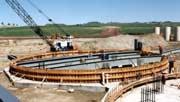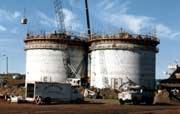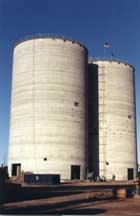|
Desalination Estimate The Dead Sea Water Project desalination plan is to use large concrete towers built with latest slip form technology to provide containment buildings that will house the equipment and condenser assembly. Multiple centrifugal vapor compressors having a combined output of 8 metric tons per second, and total power rating of about 100,000 kW, will be mounted in the top of each building above a demisting grid. The individual compressors will have free vapor intake, and be connected by ducts to the condenser assembly.
High-pressure seawater will be sprayed on the outer surface of the condenser tubes, providing an efficient evaporation environment within the low vapor pressure produced by evacuating air from the building. Heat will be transferred from the condensing vapor inside the tubes to the evaporating seawater on the tubesí outer surface. The brine concentrated by the evaporation process will drop to the floor of the building, to be expelled by pumping, and sent to the Dead Sea. Heat from the brine and the distillate will be exchanged with the incoming feed water. Air will be continuously evacuated by venturi, using the distillate as the motive fluid, from the bottom of the condenser assembly. Since air is heavier than water vapor, air will collect in the bottom of the condenser assembly just above the distillate, and can be continuously removed with the distillate, which will be removed by pumping. This continuous air evacuation will maintain the low vapor pressure within the building. One most desirable feature of this design is that the low operating temperature will inhibit the buildup of scale on the evaporation surface. IDE Tech has estimated that scale removal for such a low temperature process will be necessary only once in five years. This minimizes the need for expensive and environmentally harmful chemical additives to the feed water. Cost of the vapor compressors is the most expensive part of the desalination plant, and it is estimated that the compressors for one plant will cost $40 million installed. One plant will cost an estimated $200 million, or $800 million for the total first stage desalination project capacity of one billion cubic meters annual output. The price of water sold by this project to recover investment and operating costs will be about forty cents per metric ton. Four of the proposed units will produce a total volume of thirty-two cubic meters per second, or about one billion cubic meters per year, worth $400 million. The 1500 megawatt hydropower plant, which will operate as a peaking power plant, operating eight hours per day, would produce an income of about $400 million yearly. Total projected annual gross income for the project could be as much as $800 million. This project would be planned and constructed under the auspices of the World Bank, using private financing, and with income guaranteed to investors by the necessary international agreements by the affected nations. The kingdom of Jordan would have to initiate the project, because of their standing with the World Bank. Israel and Palestine would join with Jordan in planning the project, with the support of interested nations. (The above information is being provided as part of an unsolicited design proposal for the Dead Sea Water Project). Randolph Gonce |


